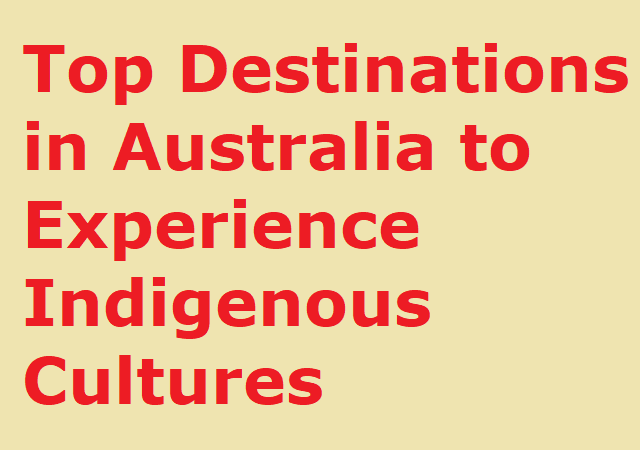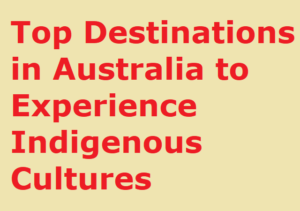Top Destinations in Australia to Experience Indigenous Cultures:
Australia has a distinctive cultural legacy that has persisted for thousands
of years. The native tribes across the nation still possess artifacts from
these cultures. At the heart of Australian aboriginal tradition are
ceremonial ceremonies, pictographs and prehistoric art, ancient pilgrimages,
and all the tales passed down from father to son and generation to
generation.
Australia has a distinctive cultural legacy that has persisted for thousands
of years. The native tribes across the nation still possess artifacts from
these cultures. At the heart of Australian aboriginal tradition are
ceremonial ceremonies, pictographs and prehistoric art, ancient pilgrimages,
and all the tales passed down from father to son and generation to
generation.
These intriguing traditions are now blended with superb accommodations,
delectable modern cuisine, and top-notch amenities to glimpse the Australian
aboriginal communities’ daily lives and cultures. We have compiled a list of
Australia’s greatest attractions with a strong indigenous component. Check
out here Top Destinations in Australia to Experience Indigenous Cultures
related information.
delectable modern cuisine, and top-notch amenities to glimpse the Australian
aboriginal communities’ daily lives and cultures. We have compiled a list of
Australia’s greatest attractions with a strong indigenous component. Check
out here Top Destinations in Australia to Experience Indigenous Cultures
related information.
Top Destinations in Australia to Experience Indigenous Cultures:
1. The Great Barrier Reef, Queensland:
The Great Barrier Reef, a coral phenomenon and one of the world’s natural
marvels, has much to offer. The most noticeable attractions are the
turquoise coasts bordered by white stretches of sand, the underwater world
with astounding marine life, the towering coral mountains, tropical
hinterlands, unique coral cays, and charming communities nearby.
marvels, has much to offer. The most noticeable attractions are the
turquoise coasts bordered by white stretches of sand, the underwater world
with astounding marine life, the towering coral mountains, tropical
hinterlands, unique coral cays, and charming communities nearby.
Aboriginal and Torres Strait Islander natives who still practice their
nature-based customs and culture have also lived near the Great Barrier
Reef. It has been inhabited by Aboriginal and Torres Strait Islander
indigenous who retain their traditions and culture intertwined with
nature.
nature-based customs and culture have also lived near the Great Barrier
Reef. It has been inhabited by Aboriginal and Torres Strait Islander
indigenous who retain their traditions and culture intertwined with
nature.
The barrier, known locally as Uiure, is dotted with historical monuments,
settlements, and early Aboriginal artwork. Visitors to these native areas
are rewarded with guided tours of the holy places, fireside tales, and
sometimes even a taste of the local cuisine.
settlements, and early Aboriginal artwork. Visitors to these native areas
are rewarded with guided tours of the holy places, fireside tales, and
sometimes even a taste of the local cuisine.
2. Darwin, Northern Territory:
Darwin is a small town with a military history from the postcolonial era
and characteristic Australian wildlife. People gather each August during the
Garma festival from all over the world to participate in the indigenous
celebration of the original landowners of the ancient and sacred planes of
Gulkula; a place loved for more than 20,000 years.
and characteristic Australian wildlife. People gather each August during the
Garma festival from all over the world to participate in the indigenous
celebration of the original landowners of the ancient and sacred planes of
Gulkula; a place loved for more than 20,000 years.
The festival lasts four days, during which time Red Flag dancers from
Numbulwar, You tribal members from the northeast of Arnhem Land, and other
visiting tribes from throughout the nation perform several traditional rites
and performances. Then, contemporary components are added to the traditional
ceremonies, showcasing non-native participants and musicians worldwide. The
festival, which was once a sacred ceremony, now serves as a link between
Australian natives and non-natives, bringing them together and fostering
cross-cultural understanding.
Numbulwar, You tribal members from the northeast of Arnhem Land, and other
visiting tribes from throughout the nation perform several traditional rites
and performances. Then, contemporary components are added to the traditional
ceremonies, showcasing non-native participants and musicians worldwide. The
festival, which was once a sacred ceremony, now serves as a link between
Australian natives and non-natives, bringing them together and fostering
cross-cultural understanding.
3. Grampians National Park:
Are pictographs and rock paintings your thing? Grampians is a must-see
destination, so. The park’s bush walk routes take tourists through the
pristine nature and include over 90% Victorian indigenous art.
destination, so. The park’s bush walk routes take tourists through the
pristine nature and include over 90% Victorian indigenous art.
The Brambuk Cultural Centre, which is nearby and situated within the
national park of the same name, provides:
national park of the same name, provides:
Guided safaris.
Arduous nature hikes that lead to beautiful overlooks.
Tours of the area’s unique flora and native treasures.
4. Uluru–Kata Tjuta national park, Northern Territory:
The Australian Central Desert’s plains are considered sacred because of
their gorgeous monolith, red-hued desert, and beautiful sunsets.
their gorgeous monolith, red-hued desert, and beautiful sunsets.
Perhaps the desert’s natural stillness and mystifying character act as a
spiritual beckoning, or perhaps the creation stories and allegorical
mysteries that emerged from the philosophical aspirations of the people who
lived here. In either case, Uluru-Kata Tjuta exudes a mysterious aura
preserved in annual celebrations, rock carvings, and symbolic devotion among
the aboriginal populations up to the present.
spiritual beckoning, or perhaps the creation stories and allegorical
mysteries that emerged from the philosophical aspirations of the people who
lived here. In either case, Uluru-Kata Tjuta exudes a mysterious aura
preserved in annual celebrations, rock carvings, and symbolic devotion among
the aboriginal populations up to the present.
The stunning monolith, red-hued desert, and breathtaking Australian Central
Desert plains sunsets are sacred spaces.
Desert plains sunsets are sacred spaces.
The desert’s inherent silence and perplexing qualities may serve as a
spiritual call, as do the creation myths and allegorical mysteries that
developed from the residents’ aspirations to understand philosophy.
Regardless of the situation, Uluru-Kata Tjuta radiates a mystic atmosphere
perpetuated via annual ceremonies, rock carvings, and symbolic adoration
among the aboriginal communities up to the present.
spiritual call, as do the creation myths and allegorical mysteries that
developed from the residents’ aspirations to understand philosophy.
Regardless of the situation, Uluru-Kata Tjuta radiates a mystic atmosphere
perpetuated via annual ceremonies, rock carvings, and symbolic adoration
among the aboriginal communities up to the present.
5. Mungo National Park:
Following the discovery of the well-preserved bodies of the Mungo Lady and
the Mungo Man, it is estimated that indigenous people have lived among the
arid terrain of Mungo National Park and the magnificent patterns created by
the sediments of the long-gone Mungo Lake for over 40,000 years. These
ancient finds are on display in the National Museum of Australia.
the Mungo Man, it is estimated that indigenous people have lived among the
arid terrain of Mungo National Park and the magnificent patterns created by
the sediments of the long-gone Mungo Lake for over 40,000 years. These
ancient finds are on display in the National Museum of Australia.
The lake region, designated a UNESCO World Heritage Site, was formerly a
sacred burial site. The Paakantji and Ngiyampaa communities currently live
in the park as their ancestral home. They also take part in local aboriginal
and ecological exploration trips. These tours involve seeing the white
dunes, desolate areas with peculiar geological structures, and unusual
animals.
sacred burial site. The Paakantji and Ngiyampaa communities currently live
in the park as their ancestral home. They also take part in local aboriginal
and ecological exploration trips. These tours involve seeing the white
dunes, desolate areas with peculiar geological structures, and unusual
animals.
6. Flinders Ranges National Park:
The Nukunu tribes have lived in the Flinders Ranges National Park for
countless years, making it one of the cultural pillars of the ancient
Australian heritage. Bushwalking and hiking on the slopes of the Flinders
Ranges are popular activities in this area because of their stunning scenery
and distinctive species. The Sacred Canyon, located near Wilpena Pound, is
famous worldwide for its rock carvings and adjoining trail etchings made by
the ancient aboriginals who used it to mark their routes between their
settlements and their hunting grounds.
countless years, making it one of the cultural pillars of the ancient
Australian heritage. Bushwalking and hiking on the slopes of the Flinders
Ranges are popular activities in this area because of their stunning scenery
and distinctive species. The Sacred Canyon, located near Wilpena Pound, is
famous worldwide for its rock carvings and adjoining trail etchings made by
the ancient aboriginals who used it to mark their routes between their
settlements and their hunting grounds.
According to indigenous mythology, the Wilpena Pound mountains were formed
by the remains of two enormous snakes that ate a large number of people
during a ritual but were unable to travel any further, giving rise to the
mountain ranges known in the original tongue as the Adnyamathanha. Other
noteworthy features are the Pound Gap Track, the Old Wilpena Station with
its rich history, and the superb biodiversity in Brachina Gorge.
by the remains of two enormous snakes that ate a large number of people
during a ritual but were unable to travel any further, giving rise to the
mountain ranges known in the original tongue as the Adnyamathanha. Other
noteworthy features are the Pound Gap Track, the Old Wilpena Station with
its rich history, and the superb biodiversity in Brachina Gorge.
7. Kakadu national park, Northern Territory:
The landscapes in the Kakadu National Park are breathtaking. These
landscapes are covered in untamed nature and renowned for their abundance of
waterfalls connected by rock pools, emerald rivers, amazing fauna, and lush
forest. Due to its exotic birdlife and exotic land animals, the park is
listed as a world heritage site and a popular safari destination.
landscapes are covered in untamed nature and renowned for their abundance of
waterfalls connected by rock pools, emerald rivers, amazing fauna, and lush
forest. Due to its exotic birdlife and exotic land animals, the park is
listed as a world heritage site and a popular safari destination.
Additionally, Kakadu safeguards several indigenous tribes and is home to a
vibrant culture that has existed in harmony with nature for ages. Along with
the Burrungkuy region and hundreds of other historically significant spots,
Ubirr Rock is a well-known location to view the artistic thumbprints of the
indigenous forefathers. This area’s rock carvings and artifacts represent a
priceless heritage from more than 50,000 years ago, making this the oldest
continuously populated terrain on earth. I hope you got all explain about
Top Destinations in Australia to Experience Indigenous Cultures.
vibrant culture that has existed in harmony with nature for ages. Along with
the Burrungkuy region and hundreds of other historically significant spots,
Ubirr Rock is a well-known location to view the artistic thumbprints of the
indigenous forefathers. This area’s rock carvings and artifacts represent a
priceless heritage from more than 50,000 years ago, making this the oldest
continuously populated terrain on earth. I hope you got all explain about
Top Destinations in Australia to Experience Indigenous Cultures.

